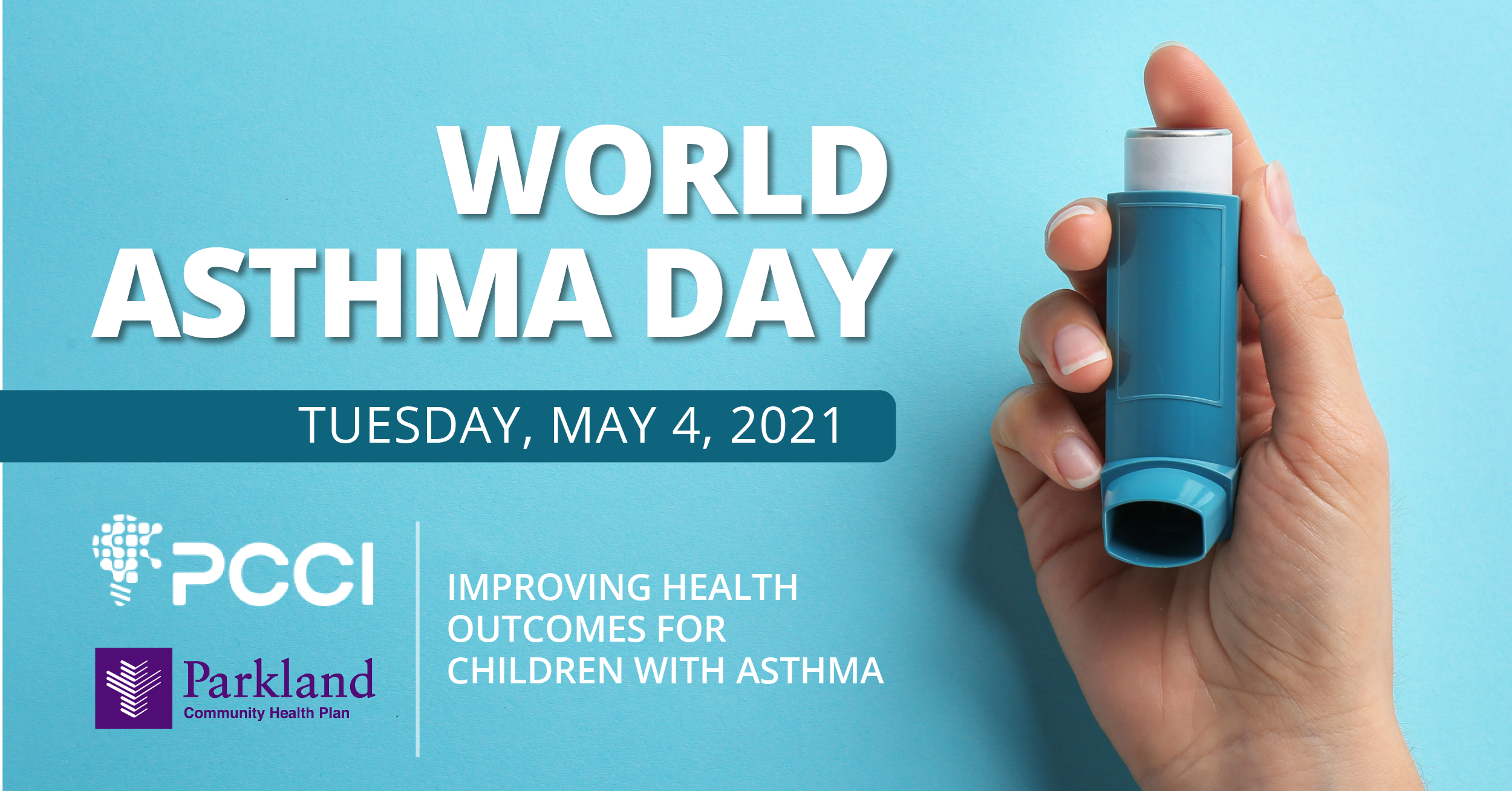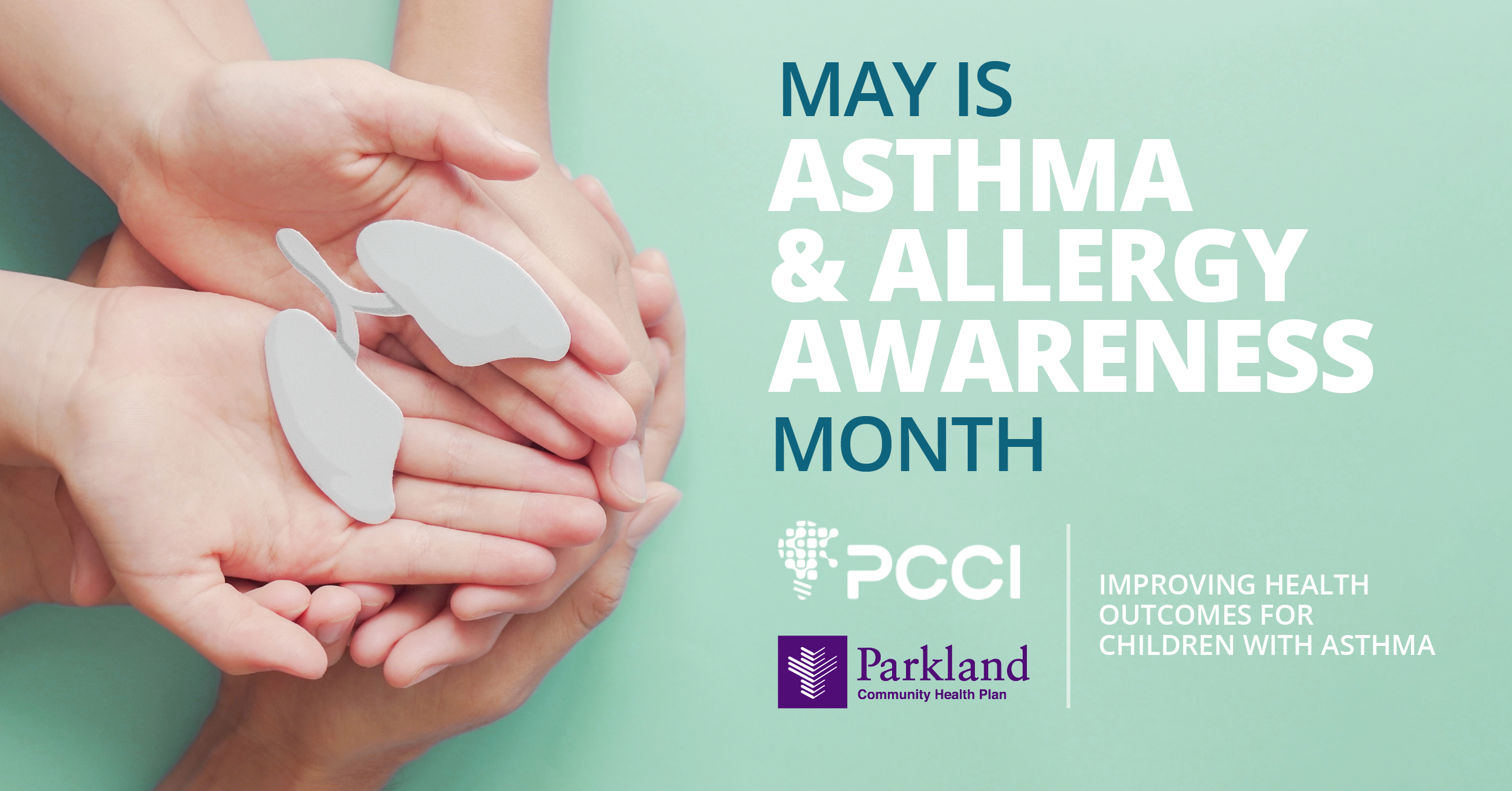As part of May’s Asthma Awareness Month and World Asthma Day (May 4), PCCI is presenting its work, partnering with Parkland and the Parkland Community Health Plan, where its platform supporting pediatric asthma has helped thousands of children, dramatically reduced hospital visits and resulted in millions of dollars in cost savings. Following is an overview of the pediatric asthma programs that PCCI has played a key role in developing.
##
How PCCI’s predictive model helped improve care low-income children with asthma in Dallas
By Yolande Pengetnze, MD, MS, FAAP,
Senior Medical Director, Parkland Center for Clinical Innovation
Bringing together advanced data science and clinical expertise to help at-risk populations is a primary mission at PCCI and the results derived from our program to help improve care and outcomes for children with asthma, demonstrate the effectiveness of this approach.
Working closely with leaders from Parkland Community Health Plan’s (PCHP) team, PCCI developed a predictive model to help reduce the incidence and cost of asthma-related emergency department (ED) visits and hospitalizations among Medicaid-insured low-income Dallas children.
 PCHP and PCCI launched the Pediatric Asthma Quality Improvement Program in April 2015. The program was driven by the large number of PCHP members with asthma. Asthma is the most common chronic disease of childhood affecting over 6 million children in the US and resulting in over 140,000 hospitalizations every year.
PCHP and PCCI launched the Pediatric Asthma Quality Improvement Program in April 2015. The program was driven by the large number of PCHP members with asthma. Asthma is the most common chronic disease of childhood affecting over 6 million children in the US and resulting in over 140,000 hospitalizations every year.
Asthma disproportionately impacts low-income, urban, Medicaid-insured children compared with privately insured children. Asthma, however, also is an ambulatory-care sensitive condition, meaning that appropriate outpatient care and self-care can prevent unnecessary ED visits and hospitalizations, with subsequent substantial direct and indirect costs savings. The opportunity was ripe to really help disadvantaged children with asthma.
How the predictive model works
Beginning in 2014, PCCI developed a logistic regression model to predict asthma emergency department (ED) visits or hospitalizations within the following three months for children with asthma, using clinical, health services utilization and socio-demographic variables from Medicaid claims data. The risk prediction model classifies every patient as Very-High-, High-, Medium-, or Low-risk for asthma ED visits or hospitalizations and the prediction is updated every month, based on new data input.
Compared to published predictive models, PCCI’s model has a very good predictive accuracy (C-statistic 0.84), is derived from a relatively large and diverse population [3] and is well-evaluated [4]. The PCCI asthma model is continuously evaluated and updated every year, to improve its accuracy and enhance actionable insights that guide clinical and community-based interventions. Deep learning methods have been and additional Non Medical Drivers of Health (NMDOH) data have been evaluated to enhance model accuracy. Communitywide data sources have been incorporated to improve and fully assess model impact. Using this model, we were able to predict high risk asthma patients. We have integrated the risk-score into the electronic health record (EPIC) at Parkland as a Best Practice Alert (BPA), to drive timely and streamlined point-of-care interventions. We also generate monthly reports sent to frontline providers and Case Management teams and other non-traditional stakeholders. The monthly reports contained just the right amount of information on patients’ risk profile to drive seamless clinical and cross-organizational workflow integrations and tailored population-level interventions.
The interventions are adaptable: the reports are used, at the providers’ discretion, to either augment or streamline existing interventions or initiate targeted interventions, depending on clinical/community settings, resources, and priorities. The ultimate goals are to reduce unnecessary hospital utilization and cost, increase patient adherence to medication and preventive office visits, and improve overall health care experience. Moreover, we use the risk prediction model to directly engage higher risk patients into a text messaging program for patient education and medication reminders.
Finally, we used patient’s risk-stratification to identify providers caring for the highest risk patients and community sources of high-risk children for enhanced support for program participation and community-based interventions.
Dallas County Community Health Needs Assessment (CHNA) Quality Improvement (QI) Initiative
In 2019, Dallas County performed a Community Health Needs Assessment (CHNA) through which pediatric asthma was identified as a driver of high morbidity among children in the county. In 2020, a communitywide quality improvement (QI) program was launched aiming to improve asthma outcomes for all Dallas County children through data-driven interventions and cross-systems care coordination, following the PCCI Asthma Program model. To support this community-wide initiative, we enhanced our asthma risk prediction model with the addition of electronic health records data, which, together with claims and Non Medical Drivers of Health (NMDOH) data, predict asthma risk among Dallas County children with asthma.
The new model retains a good prediction ability and provides additional clinical insights not previously available using claims data only. With the addition of electronic health records data, our new asthma model can be used for all children irrespective of insurance status, thus expanding the benefits of our program to more vulnerable children with asthma. The asthma text messaging program also has been expanded to impact all children with asthma, irrespective of insurance status.
Moreover, community-based services providers in the social and Public Health sectors have been engaged to use PCCI asthma risk reports for community-based interventions beyond the traditional health care system. Community-based organizations and the Dallas County Health and Human Services department now use PCCI risk reports to drive community-based interventions such as home visits and outreach in community gatherings. The Dallas independent school district is also being engaged to use the risk reports for school-based interventions.
PCCI’s asthma risk model and reports are driving cross-organizational workflows and communitywide care coordination across North Texas, to improve health, educational, and quality of life outcomes for children with asthma and their families.
Insightful Community Risk Mapping
Over the past two years, we have added data insights capability to the program using local and regional maps to identify geographical areas with high risk patients and support targeted community outreach. Overlaying asthma risk maps with NMDOH maps (down to the block group level, see above) has uncovered discrete neighborhoods with asthma-risk and high social needs that might contribute to poor asthma outcomes, including transportation and childcare needs. These opportunity maps are driving community engagement to improve health, education, and wellbeing of children with asthma and their families.
Results

Since inception, PCCI’s pediatric asthma population health framework has not only reduced unnecessary hospital visits and costs, it has improved the healthcare experience for thousands of pediatric patients and their parents. The updated five-year impact report includes:
• Program expanded to support the communitywide Dallas County CHNA Asthma Quality Improvement initiative
• ~93,000 unique children with asthma risk-stratified to-date across both initiatives (PCHP and CHNA Asthma QI)
• Over 22,000 children with asthma risk-stratified every month and ~45,000 every year, with a rapidly increasing impact
• Over ~1800 high-risk children with asthma impacted by the text messaging program
• 21 large and medium community healthcare provider practices actively engaged, including two large Federally Qualified Health Centers (FQHC) and Parkland’s large network of community-oriented primary care clinics (COPC)
• Non-traditional community services providers engaged, including community-based organizations, Dallas County Health and Human Services community health workers, and Dallas ISD, using risk reports for community-, home-, and school-based interventions
• Dallas Fort Worth Hospital Council Foundation engaged as a source of comprehensive communitywide data to support data-driven interventions
• 30 – 40 percent reduction in asthma-related ED visits
• 50 percent reduction in asthma-related inpatient admissions
• 50 percent drop in annual total asthma cost to PCHP
• Approx. $30 million saved as a result of the risk-driven, multi-stakeholder pediatric asthma framework
• Moreover, the text messaging program has yielded an additional 6-fold drop in asthma-related ED visits among participants vs. non-participants
• Over 85% of participants remain in the text messaging program for more than 12 months and >90% feel empowered to care for asthma as a result of the program
Ongoing Program Enhancements
As we continue this program, we are evaluating the role of emerging deep learning models to improve our risk prediction model performance and explanation. Our original logistic regression model served as the baseline benchmark against which deep learning model results would be compared. We, also, are looking into adding block-level Non Medical Drivers of Health to provide additional actionable insights into patients’ asthma risk profile.
Claims data have strengths and insufficiencies worth highlighting. Claims data consist of billing codes that health care providers and facilities submit to payers. claims data follow a consistent format and use a standard set of pre-established codes that describe specific diagnosis, procedures, medications, as well as billed and paid amounts [5]. Additionally, claims data document nearly all interactions a patient has across all the health care systems. They capture broader information for patients and provide access to larger and more diverse patient cohort. Claims data, however, have a time lag of about 30 to 90 days due to the processing time before they are finally added to the database and become available for analysis. We have begun the process of bringing in additional and timely data sources to enhance or supplement claims data, including electronic health records data and communitywide health and social data, which are progressively improving the timeliness, accuracy, and insights of our asthma risk prediction models and risk reports.
Conclusion
In conclusion, patient education, preventive care, and appropriate use of asthma controller medications are the cornerstone of effective asthma care. Accurate risk prediction of asthma ED visits or hospitalizations, timely provider reports, patient education, and communitywide stakeholder engagement drive the prioritization of evidence-based interventions tailored to the highest risk patients, to efficiently reduce asthma-related ED visits/hospitalizations and associated costs, and improve care experience among children with asthma. By bringing together all the factors from PCCI’s predictive model and applying them to thoughtful and direct interventions, at-risk group of children and their families can experience better outcomes that are beneficial from the health, cost, societal, and consumer experience perspectives. Through our comprehensive approach to whole-person care, , the benefits of PCCI’s risk -driven asthma quality improvement initiatives, which started with one health plan, are now reaching deeper into the North Texas community, bringing quality, coordinated care to vulnerable children where they live, learn, and play.
About the author
Yolande Pengetnze, MD, MS, FAAP, Senior Medical Director, joined PCCI in December 2013 as a Physician Scientist while remaining a Clinical Faculty at the University of Texas South Western (UTSW) School of Medicine and a practicing pediatrician at Children’s Health in Dallas, Texas. Her interests include the use of advanced predictive analytics integrating traditional and novel data sources to improve health outcomes at the individual and population level. She currently leads multiple projects at PCCI, including two population health quality improvement projects in pediatric asthma and preterm birth risk prevention. She received her MD in 1998 from the University of Yaounde in Cameroon, completed a Pediatric Residency training in 2008 at Maimonides Medical Center in New York City, and a Master of Science in Clinical Science at UTSW.
[1] M. Xu, K. G. Tantisira, A. Wu, A. A. Litonjua, J.-h. Chu, B. E. Himes, A. Damask, and S. T. Weiss. Genome wide association study to predict severe asthma exacerbations in children using random forests classifiers. BMC medical genetics, 12(1):90, 2011.
[2] E. Forno, A. Fuhlbrigge, M. E. Soto-Quirós, L. Avila, B. A. Raby, J. Brehm, J. M. Sylvia, S. T. Weiss, and J. C. Celedón. Risk factors and predictive clinical scores for asthma exacerbations in childhood. Chest, 138(5):1156– 1165, 2010.
[3] M. Schatz, E. F. Cook, A. Joshua, and D. Petitti. Risk factors for asthma hospitalizations in a managed care organization: development of a clinical prediction rule. The American journal of managed care, 9(8):538–547, 2003.
[4] A. L. Andrews, A. N. Simpson, W. T. Basco Jr, R. J. Teufel, et al. Asthma medication ratio predicts emergency department visits and hospitalizations in children with asthma. Medicare & Medicaid research review, 3(4), 2013.
[5] W. J and B. A. The benefit of using both claims data and electronic medical record data in health care analysis. Technical report, Optum Insight, 2012.










 PCHP and PCCI launched the Pediatric Asthma Quality Improvement Program in April 2015. The program was driven by the large number of PCHP members with asthma. Asthma is the most common chronic disease of childhood affecting over 6 million children in the US and resulting in over 140,000 hospitalizations every year.
PCHP and PCCI launched the Pediatric Asthma Quality Improvement Program in April 2015. The program was driven by the large number of PCHP members with asthma. Asthma is the most common chronic disease of childhood affecting over 6 million children in the US and resulting in over 140,000 hospitalizations every year.






 To better serve pregnant women in our community, PCCI and PCHP developed and implemented an innovative maternal health program that uses a machine learning algorithm, healthcare data and Non Medical Drivers of Health to identify pregnant women who are at a higher risk of pre-term birth. The program engages these women through text messages designed to help them be proactive in seeking care during pregnancy.
To better serve pregnant women in our community, PCCI and PCHP developed and implemented an innovative maternal health program that uses a machine learning algorithm, healthcare data and Non Medical Drivers of Health to identify pregnant women who are at a higher risk of pre-term birth. The program engages these women through text messages designed to help them be proactive in seeking care during pregnancy.

 Dallas, Texas – Parkland Center for Clinical Innovation (PCCI), which improves healthcare for vulnerable populations using advanced data science and clinical experts, has named Russell “Rusty” Lewis as Chief Digital Technology Officer, where he will accelerate the advancement of PCCI’s digital technology platform and data applications.
Dallas, Texas – Parkland Center for Clinical Innovation (PCCI), which improves healthcare for vulnerable populations using advanced data science and clinical experts, has named Russell “Rusty” Lewis as Chief Digital Technology Officer, where he will accelerate the advancement of PCCI’s digital technology platform and data applications.
 “After the holidays, we had vulnerability index ratings at nearly 200, which meant the COVID-19 virus was running rampant through our community,” said George “Holt” Oliver, MD, Vice President of Clinical Informatics at PCCI. “It is a great relief to see that the highest vulnerability index rating now is only 16.91. This is a triumph for our county’s public health leaders, providers and residents who have made the sacrifices and efforts needed to bend the curve.”
“After the holidays, we had vulnerability index ratings at nearly 200, which meant the COVID-19 virus was running rampant through our community,” said George “Holt” Oliver, MD, Vice President of Clinical Informatics at PCCI. “It is a great relief to see that the highest vulnerability index rating now is only 16.91. This is a triumph for our county’s public health leaders, providers and residents who have made the sacrifices and efforts needed to bend the curve.” Currently, the 75150 ZIP code, at the intersection of Interstate Highway 30 and 635 has the highest COVID-19 risk at 16.91, down from a high of 107.30 in January. The ZIP code 75204, in east downtown Dallas, has the second highest vulnerability level at 15.81, down from a high of 126.5 in January.
Currently, the 75150 ZIP code, at the intersection of Interstate Highway 30 and 635 has the highest COVID-19 risk at 16.91, down from a high of 107.30 in January. The ZIP code 75204, in east downtown Dallas, has the second highest vulnerability level at 15.81, down from a high of 126.5 in January.